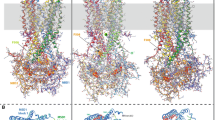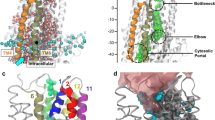Abstract.
We describe herein an atomic model of the outward-facing three-dimensional structure of the membrane-spanning domains (MSDs) and nucleotide-binding domains (NBDs) of human cystic fibrosis transmembrane conductance regulator (CFTR), based on the experimental structure of the bacterial transporter Sav1866. This model, which is in agreement with previous experimental data, highlights the role of some residues located in the transmembrane passages and directly involved in substrate translocation and of some residues within the intracellular loops (ICL1–ICL4) making MSD/NBD contacts. In particular, our model reveals that D173 ICL1 and N965 ICL3 likely interact with the bound nucleotide and that an intricate H-bond network (involving especially the ICL4 R1070 and the main chain of NBD1 F508) may stabilize the interface between MSD2 and the NBD1F508 region. These observations allow new insights into the ATP-binding sites asymmetry and into the molecular consequences of the F508 deletion, which is the most common cystic fibrosis mutation.
Similar content being viewed by others
Author information
Authors and Affiliations
Corresponding author
Additional information
Received 6 May 2008; received after revision 10 June 2008; accepted 11 June 2008
Rights and permissions
About this article
Cite this article
Mornon, JP., Lehn, P. & Callebaut, I. Atomic model of human cystic fibrosis transmembrane conductance regulator: Membrane-spanning domains and coupling interfaces. Cell. Mol. Life Sci. 65, 2594–2612 (2008). https://doi.org/10.1007/s00018-008-8249-1
Published:
Issue Date:
DOI: https://doi.org/10.1007/s00018-008-8249-1




